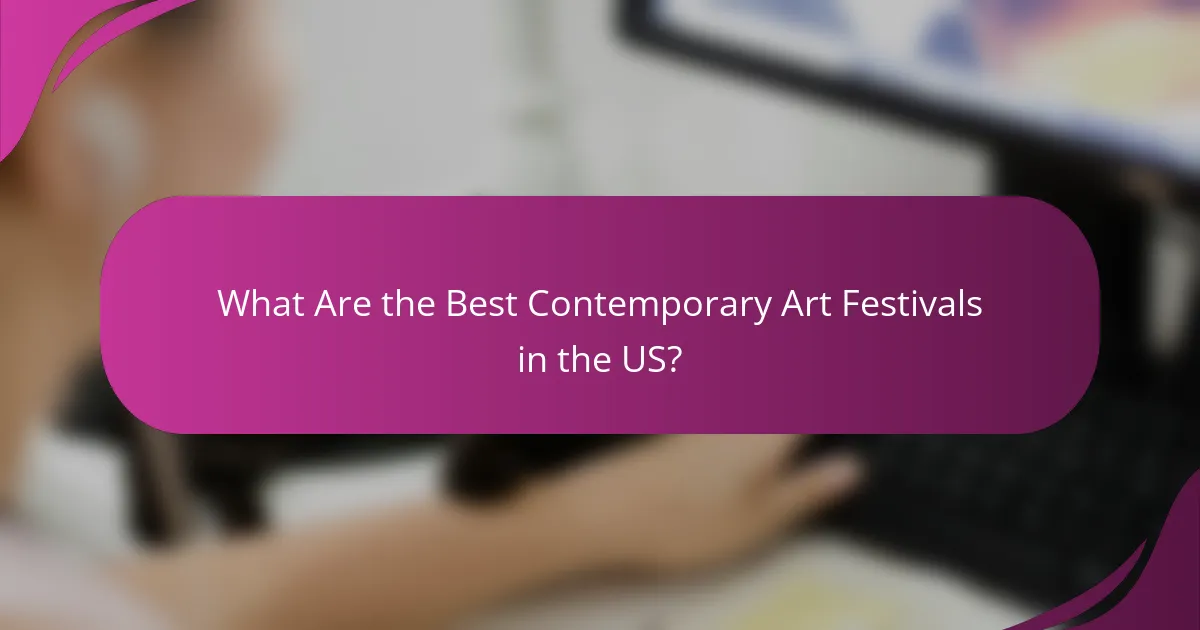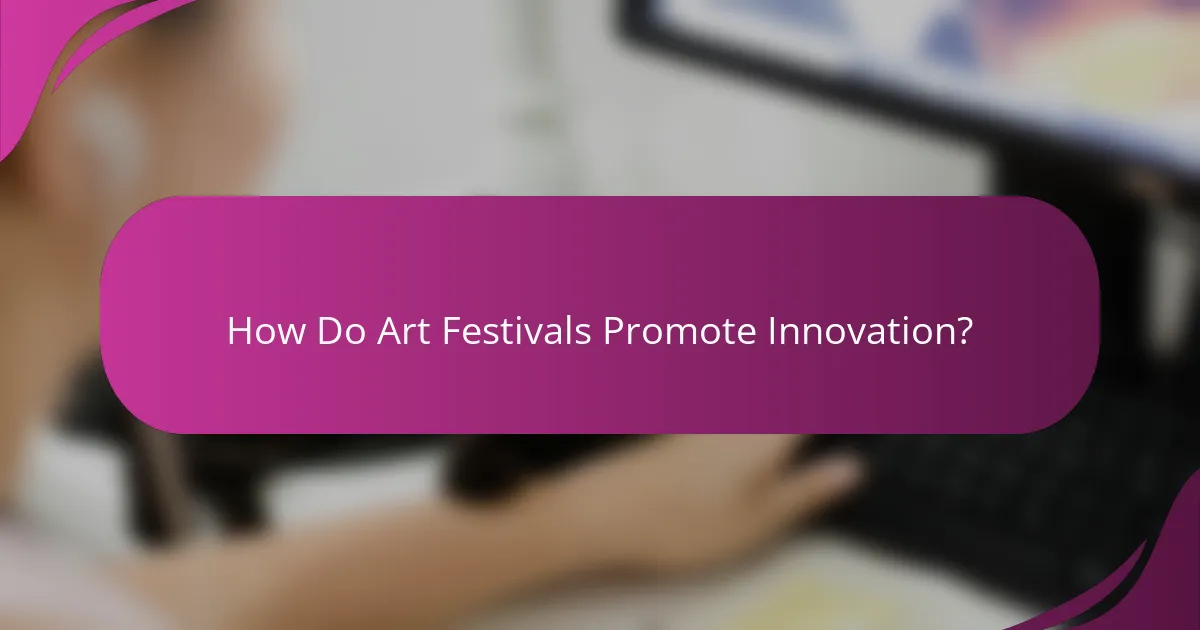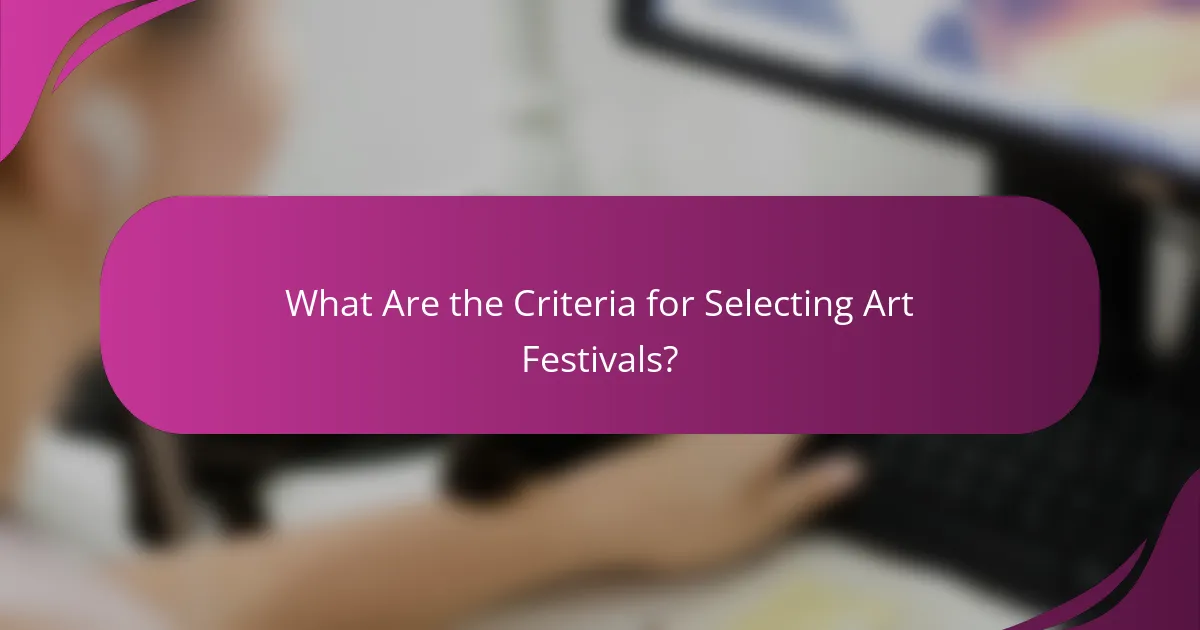The best contemporary art festivals in the US highlight innovative works while fostering engagement among artists, collectors, and the public. These vibrant events create dynamic environments for established and emerging artists to showcase their creativity, encouraging dialogue and collaboration within the art community.

What Are the Best Contemporary Art Festivals in the US?
The best contemporary art festivals in the US showcase innovative works and foster engagement among artists, collectors, and the public. These events often feature a mix of established and emerging artists, providing a platform for dialogue and exploration in the art community.
Art Basel Miami Beach
Art Basel Miami Beach is one of the premier art fairs in the US, attracting galleries and collectors from around the globe. Held annually in December, it features a wide array of contemporary artworks, including paintings, sculptures, and installations from renowned artists.
Visitors can expect a vibrant atmosphere filled with events, parties, and panel discussions. It’s essential to plan ahead, as tickets can sell out quickly, and accommodations in Miami can be pricey during the festival.
Frieze Los Angeles
Frieze Los Angeles takes place in February and highlights the city’s dynamic art scene. This festival showcases contemporary art from leading galleries and includes a curated program of talks and performances.
Attendees should consider purchasing tickets in advance and exploring the surrounding neighborhoods, which often feature additional exhibitions and events. The festival is known for its focus on innovative and thought-provoking works.
Whitney Biennial
The Whitney Biennial, held every two years at the Whitney Museum of American Art in New York City, is a key event for contemporary art. It features a selection of works by American artists, reflecting current trends and issues in the art world.
Visitors can engage with a diverse range of media and styles, making it a must-see for art enthusiasts. It’s advisable to check the museum’s website for ticketing information and special events during the Biennial.
New York Art Book Fair
The New York Art Book Fair, typically held in September, celebrates artists’ books, catalogs, and zines. This event provides a platform for independent publishers and artists to showcase their work and engage with the public.
Attendees can browse a wide selection of publications and participate in workshops and discussions. It’s an excellent opportunity for collectors and art lovers to discover unique works and meet emerging artists.
Chicago Art Expo
The Chicago Art Expo, usually held in April, is a significant event for contemporary art in the Midwest. This fair features a diverse range of artworks from local and international galleries, making it a hub for art enthusiasts and collectors.
Visitors should take advantage of the various programming and events, including artist talks and panel discussions. Planning ahead is crucial, as the expo can draw large crowds, and securing accommodations early is recommended.

How Do Art Festivals Promote Innovation?
Art festivals promote innovation by creating dynamic environments where artists can experiment with new ideas and engage with audiences in novel ways. These events serve as platforms for showcasing cutting-edge work, fostering collaboration, and integrating technology into artistic expression.
Interactive installations
Interactive installations invite audience participation, transforming viewers into active participants. These works often utilize sensors and digital interfaces, allowing visitors to influence the art through their actions, which enhances engagement and encourages creative exploration.
For example, festivals may feature installations that respond to movement or sound, creating a unique experience for each visitor. This interactivity not only captivates audiences but also challenges traditional notions of art consumption.
Emerging artist showcases
Emerging artist showcases highlight new talent and innovative practices, providing a platform for artists who may not yet have widespread recognition. These showcases often include a diverse range of mediums and styles, reflecting the evolving landscape of contemporary art.
By featuring these artists, festivals encourage fresh perspectives and ideas, fostering a culture of experimentation. Attendees can discover unique works that push boundaries and challenge conventions, enriching the overall artistic dialogue.
Technology integration
Technology integration in art festivals enhances the creative process and broadens the scope of artistic expression. Artists increasingly incorporate digital tools, virtual reality, and augmented reality into their work, creating immersive experiences that captivate audiences.
For instance, some festivals may use apps to provide augmented reality experiences that complement physical artworks, allowing viewers to engage with the art in innovative ways. This fusion of technology and art not only attracts tech-savvy audiences but also encourages artists to explore new creative avenues.

What Engagement Opportunities Do Art Festivals Offer?
Art festivals provide a variety of engagement opportunities that allow attendees to connect with artists, participate in creative activities, and immerse themselves in the art community. These opportunities often include workshops, networking events, and community art projects that foster collaboration and innovation.
Workshops and panels
Workshops and panels at art festivals are designed to educate and inspire participants. They often cover a range of topics, from contemporary art techniques to discussions on the latest trends in the art world. Attendees can expect hands-on experiences where they can create their own art or engage in critical discussions with artists and experts.
Consider signing up for workshops that match your skill level or interests. Many festivals offer sessions for beginners as well as advanced artists, ensuring that everyone can find something valuable. Look for workshops that include materials in the registration fee to avoid extra costs.
Networking events
Networking events are crucial for building connections within the art community. These gatherings provide a platform for artists, collectors, and art enthusiasts to meet, share ideas, and explore potential collaborations. Such events can take the form of informal meet-and-greets, structured discussions, or even social gatherings.
To make the most of networking opportunities, come prepared with business cards and a clear idea of what you want to achieve. Engaging in conversations about shared interests can lead to fruitful relationships. Avoid being overly promotional; instead, focus on genuine interactions.
Community art projects
Community art projects at festivals encourage collective creativity and engagement among participants. These projects often involve collaborative installations or public art initiatives that reflect the local culture and community values. They provide a unique opportunity for attendees to contribute to a larger artistic vision.
Participating in these projects can enhance your festival experience and allow you to connect with others in meaningful ways. Look for projects that welcome all skill levels and provide guidance from experienced artists. Be open to new ideas and approaches, as community art is often about exploration and shared expression.

What Are the Criteria for Selecting Art Festivals?
Art festivals are typically selected based on their reputation, artist participation, and location. These criteria help determine the festival’s overall impact, quality, and accessibility for both artists and attendees.
Reputation and history
The reputation of an art festival is often built over years, influenced by its past events and the caliber of artists it attracts. Established festivals like the Venice Biennale or Art Basel have a strong history that draws significant attention and participation.
When evaluating a festival’s reputation, consider factors such as media coverage, previous notable exhibitions, and the involvement of prestigious galleries. A strong reputation can enhance networking opportunities and increase the likelihood of attracting top-tier artists.
Artist participation
High-quality artist participation is crucial for a successful art festival. Festivals that feature a diverse range of artists, from emerging talents to established names, tend to offer richer experiences for attendees.
Look for festivals that provide opportunities for artists to engage with the audience through workshops, talks, or live demonstrations. This interaction not only enhances the festival’s appeal but also fosters a sense of community and collaboration among artists and visitors.
Location and accessibility
The location of an art festival plays a significant role in its success. Festivals held in major cities or cultural hubs often attract larger crowds due to their accessibility and the presence of related attractions.
Consider the ease of access for both artists and attendees, including transportation options and accommodation availability. Festivals that are easy to reach and navigate are more likely to draw a diverse audience, enhancing the overall experience.

How Do Art Festivals Impact Local Economies?
Art festivals significantly contribute to local economies by attracting visitors and stimulating various sectors. They create opportunities for businesses and enhance community engagement, leading to a more vibrant economic landscape.
Tourism boost
Art festivals draw tourists from both nearby regions and afar, leading to increased spending in local hotels, restaurants, and shops. This influx can elevate a city’s profile, encouraging future visits and establishing it as a cultural destination.
For example, a well-promoted festival can see attendance numbers in the thousands, translating to millions in revenue for local businesses. Cities often report a surge in hotel bookings and dining reservations during festival weekends.
Job creation
Art festivals create temporary and permanent job opportunities in various sectors, including event planning, hospitality, and retail. Local artists and vendors also benefit from increased visibility and sales during these events.
Typically, festivals require staff for setup, management, and breakdown, which can lead to short-term employment for dozens or even hundreds of individuals. Additionally, the long-term impact can foster a thriving arts community, encouraging more permanent job growth in creative industries.
